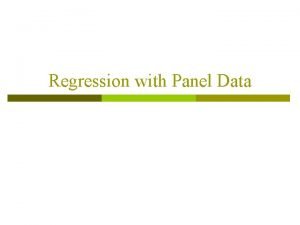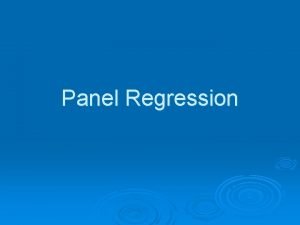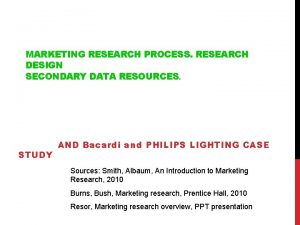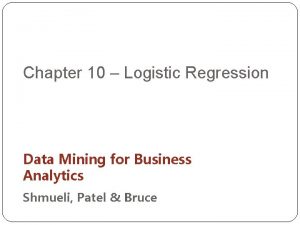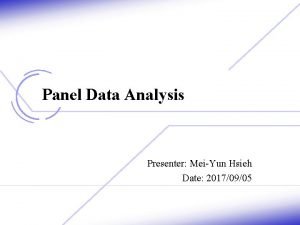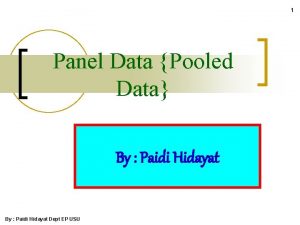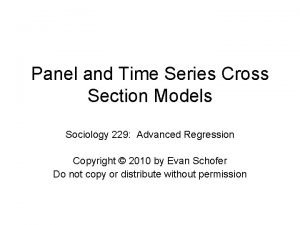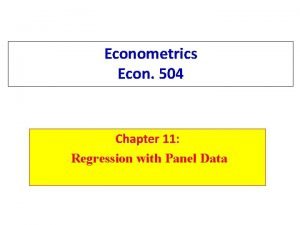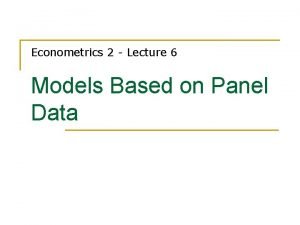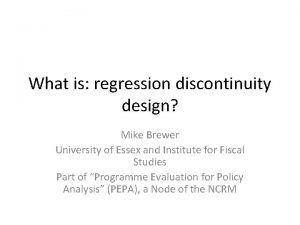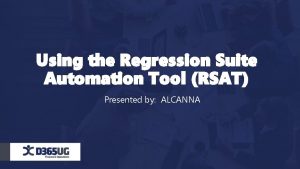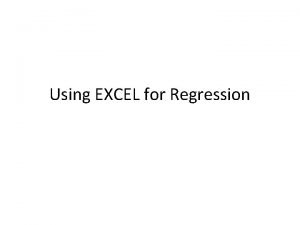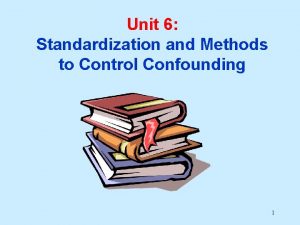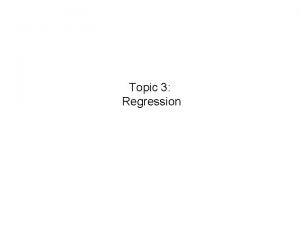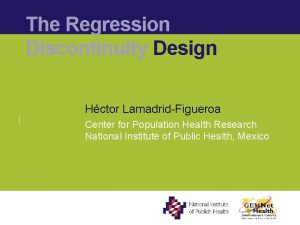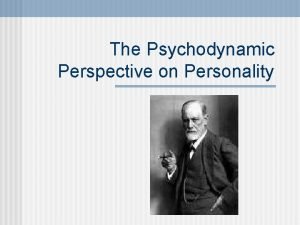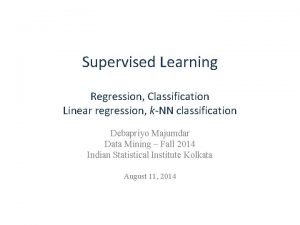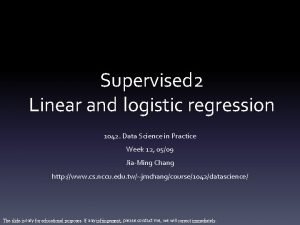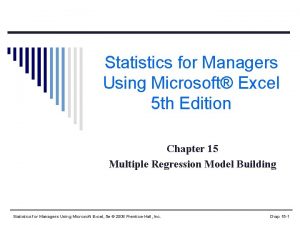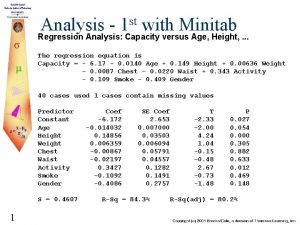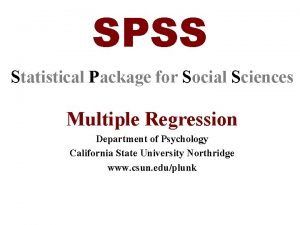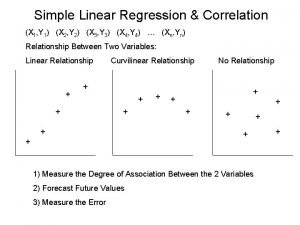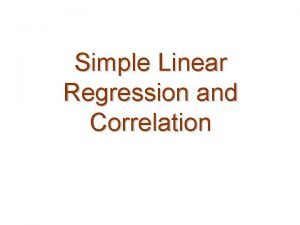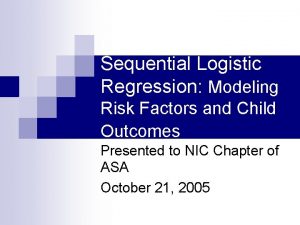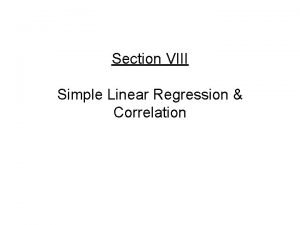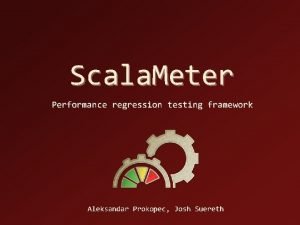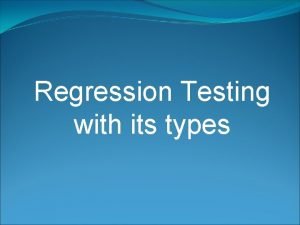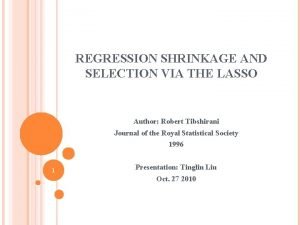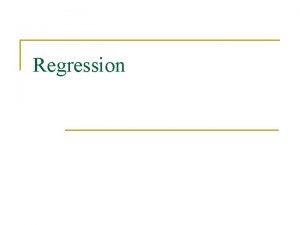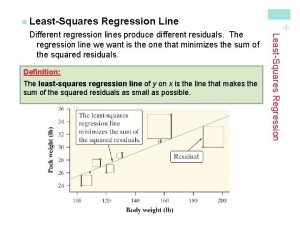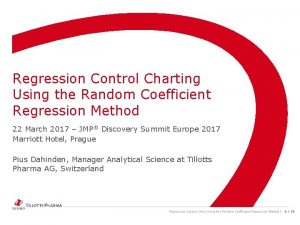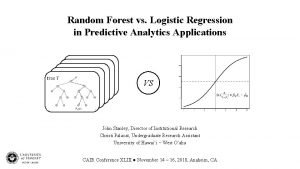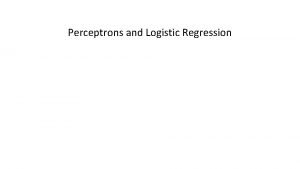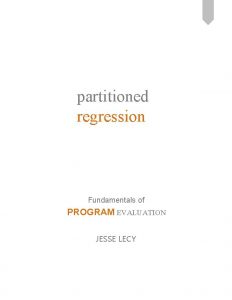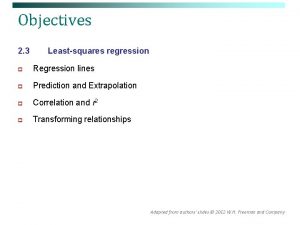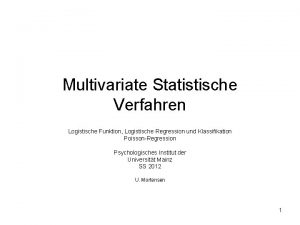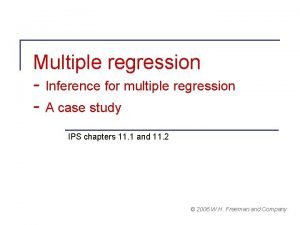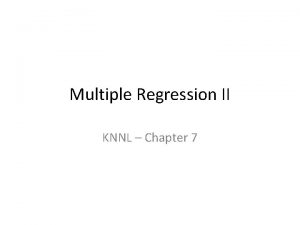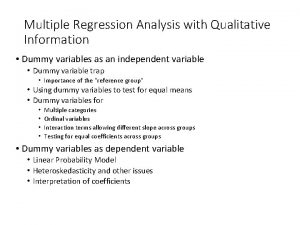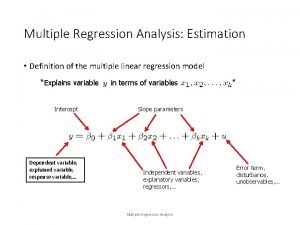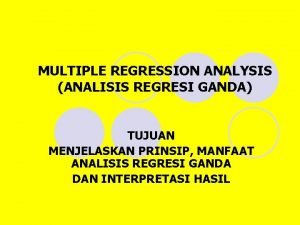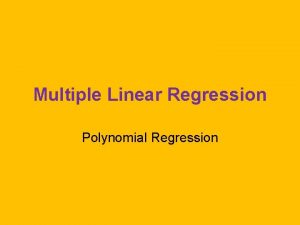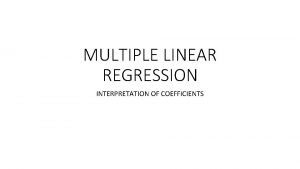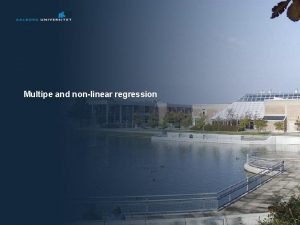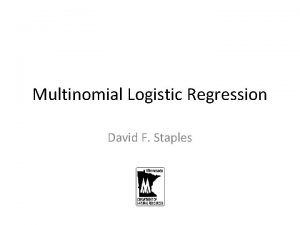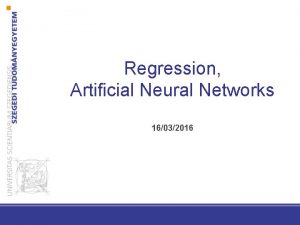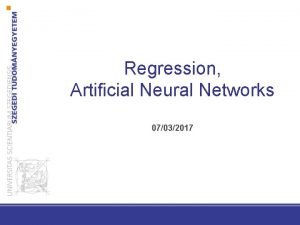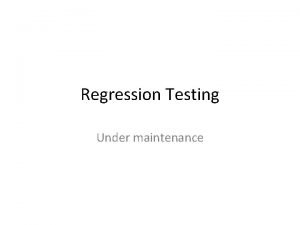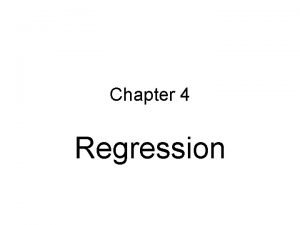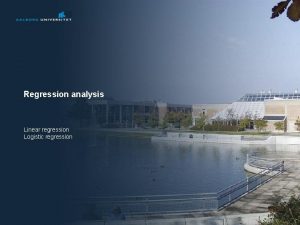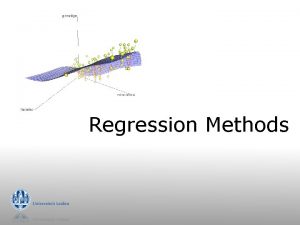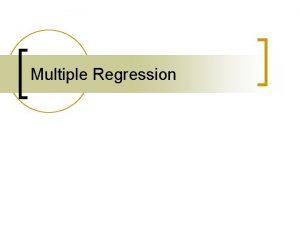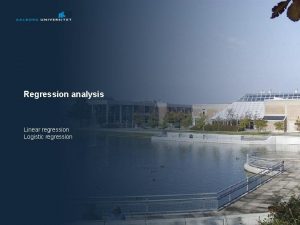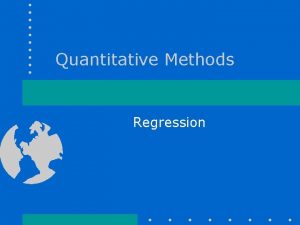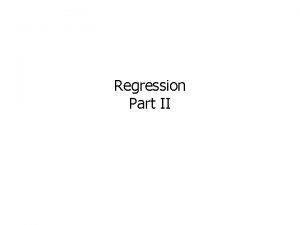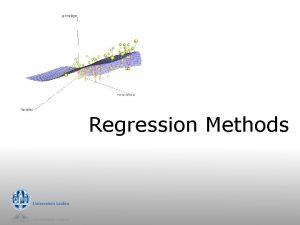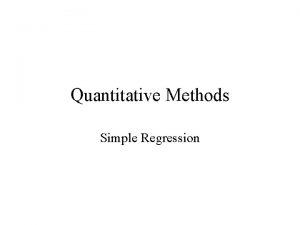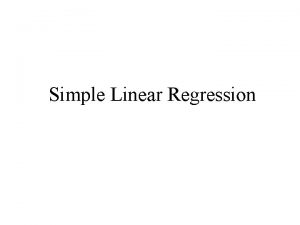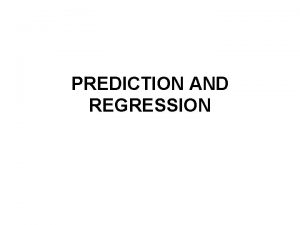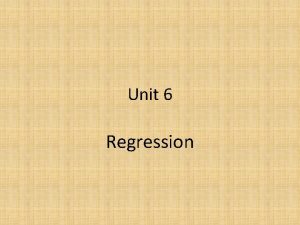Regression with Panel Data Panel Data p Panel


































































- Slides: 66

Regression with Panel Data

Panel Data p Panel Data with Two Periods p Fixed Effects Regression p n n n The Model Estimation Regression with Time Fixed Effects Assumptions p Application p

Panel Data A panel dataset contains observations on multiple entities (individuals), where each entity is observed at two or more points in time. Examples: p Data on 420 California school districts in 1999 and again in 2000, for 840 observations total. p Data on 50 U. S. states, each state is observed in 3 years, for a total of 150 observations. p Data on 1000 individuals, in four different months, for 4000 observations total.

Notation for panel data A double subscript distinguishes entities (states) and time periods (years) i = entity (state), n = number of entities, so i = 1, … , n. t = time period (year), T = number of time periods so t=1, …, T Data: Suppose we have 1 regressor. The data are (Xit , Yit ), i = 1 , … , n, t = 1 , … , T

Panel data with k regressors: (X 1 it , X 2 it , . . . , Xkit , Yit ), i = 1 , … , n, t = 1 , … , T n = number of entities (states) T = number of time periods (years) Some terminologies. p Another term for panel data is longitudinal data. p balanced panel: no missing observations. p unbalanced panel: some entities (states) are not observed for some time periods (years).

Why are panel data useful? With panel data we can control for factors that: p Vary across entities (states) but do not vary over time. p Could cause omitted variable bias if they are omitted. p are unobserved or unmeasured - and therefore cannot be included in the regression using multiple regression.

The key idea: If an omitted variable does not change over time, then any changes in Y over time cannot be caused by the omitted variable.

Example of a panel data set: Traffic deaths and alcohol taxes Observational unit: a year in a U. S. state p 48 U. S. states, so n = no. of entities = 48. p 7 years (1982, … , 1988), so T = # of time periods = 7. p Balanced panel, so total # observations = 7 × 48 = 336. Variables: p Traffic fatality rate (# traffic deaths in that state in that year, per 10, 000 state residents). p Tax on a case of beer. p Other (legal driving age, drunk driving laws, etc. ).

Traffic death data for 1982 Higher alcohol taxes, more traffic deaths?

Traffic death data for 1988 Higher alcohol taxes, more traffic deaths?

Why might there be more traffic deaths in states that have higher alcohol taxes? Other factors that determine traffic fatality rate: p Quality (age) of automobiles. p Quality of roads. p “Culture” around drinking and driving. p Density of cars on the road. These omitted factors could cause omitted variable bias.

Example #1: traffic density. Suppose: (i) High traffic density means more traffic deaths. (ii) (Western) states with lower traffic density have lower alcohol taxes. p Then the two conditions for omitted variable bias are satisfied. Specifically, “high taxes” could reflect “high traffic density” (so the OLS coefficient would be biased positively - high taxes, more deaths). p Panel data lets us eliminate omitted variable bias when the omitted variables are constant over time within a given state.

Example #2: cultural attitudes towards drinking and driving. (i) arguably are a determinant of traffic deaths, and (ii) potentially are correlated with the beer tax, so beer taxes could be picking up cultural differences (omitted variable bias). p Then the two conditions for omitted variable bias are satisfied. Specifically, “high taxes” could reflect “cultural attitudes towards drinking” (so the OLS coefficient would be biased). p Panel data lets us eliminate omitted variable bias when the omitted variables are constant over time within a given state.

Panel Data with Two Time Periods Consider the panel data model, Zi is a factor that does not change over time, at least during the years on which we have data. p Suppose Zi is not observed, so its omission could result in omitted variable bias. p The effect of Zi can be eliminated using T = 2 years.

The key idea: Any change in the fatality rate from 1982 to 1988 cannot be caused by Zi , because Zi (by assumption) does not change between 1982 and 1988. p Consider fatality rates in 1988 and 1982: p p Suppose Subtracting 1988 - 1982 (that is, calculating the change), eliminates the effect of Zi.

so The new error term, , is uncorrelated with either. p This “difference” equation can be estimated by OLS, even though Zi isn’t observed. p The omitted variable Zi doesn’t change, so it cannot be a determinant of the change in Y. p

Example: Traffic deaths and beer taxes 1982 data: 1988 data: Difference regression (n = 48)

ΔFatality Rate v. s. ΔBeer Tax

Fixed Effects Regression What if we have more than 2 time periods (T > 2)? We can rewrite this in two useful ways: 1. “n-1 binary regressor” regression. 2. “Fixed Effects” regression model. We first rewrite this in “fixed effects” form. Suppose we have n = 3 states: California, Texas, Massachusetts.

Population regression for California (that is, i = CA): or doesn’t change over time. p is the intercept for CA, and is the slope. p The intercept is unique to CA, but the slope is the same in all the states—parallel lines. p

For TX: or where p Collecting the lines for all three states: p

In binary regressor form: p p p DCAi = 1 if state is CA, = 0 otherwise. DTXi = 1 if state is TX, = 0 otherwise. leave out DMAi (why? )

Summary: Two ways to write the fixed effects model p “n-1 binary regressor” form where D 2 i = 1 if i = 2 (state #2), etc. p “Fixed effects” form: p αi is called a “state fixed effect” or “state effect” - it is the constant (fixed) effect of being in state i.

Fixed Effects Regression: Estimation Three estimation methods: 1 “n-1 binary regressors” OLS regression. 2 “Entity-demeaned” OLS regression. 3 “Changes” specification (only works for T = 2). p These three methods produce identical estimates of the regression coefficients, and identical standard errors. p We already did the “changes” pecification (1988 minus 1982) - but this only works for T D 2 years. p Methods #1 and #2 work for general T. p Method #1 is only practical when n isn’t too big.

1. “n-1 binary regressors” OLS regression where D 2 i = 1 if i D 2 (state #2), etc. p First create the binary variables D 2 i , … , Dni. p Then estimate it by OLS. p Inference (hypothesis tests, confidence intervals) is as usual (using heteroskedasticity-robust standard errors). p This is impractical when n is very large (for example if n D 1000 workers).

2. “Entity-demeaned” OLS regression p The fixed effects regression model: p The state averages satisfy:

Deviation from state averages: p For i D 1 and t D 1982, YQit is the difference between the fatality rate in Alabama in 1982, and its average value in Alabama averaged over all 7 years.

First construct the demeaned variables and. p Then estimate by regressing on using OLS. p Inference (hypothesis tests, confidence intervals) is as usual (using heteroskedasticity-robust standard errors). p This is like the “changes”, but instead Yit is deviated from the state average instead of Yi 1. p This can be done in a single command in STATA. p


For n = 48, T = 7: How many binary regressors would you include to estimate this using the “binary regressor” method? p Compare slope, standard error to the estimate for the 1988 v. 1982 “changes” specification (T = 2, n = 48): p

Regression with Time Fixed Effects An omitted variable might vary over time but not across states. p Safer cars (air bags, etc. ); changes in national laws. p These produce intercepts that change over time. p Let these changes (“safer cars”) be denoted by the variable St , which changes over time but not states. p The resulting population regression model is: p

Time fixed effects only In effect, the intercept varies from one year to the next: Or Similarly, etc.

Two formulations for time fixed effects 1. “Binary regressor” formulation: where B 2 t = 1 if t = 2 (year #2), etc. 2. “Time effects” formulation:

Time fixed effects: estimation methods p “T-1 binary regressors” OLS regression n n p Create binary variables B 2 , … , BT. B 2 = 1 if t = year #2 , = 0 otherwise. Regress Y on X, B 2 , … , BT using OLS. Where’s B 1? “Year-demeaned” OLS regression n n Deviate Yit ; Xit from year (not state) averages. Estimate by OLS using “year-demeaned” data.

State and Time Fixed Effects p “Binary regressor” formulation: p “State and time effects” formulation:

State and time effects: estimation methods p “n-1 and T-1 binary regressors” OLS regression n n p Create binary variables D 2 , … , Dn. Create binary variables B 2 , … , BT. Regress Y on X, D 2 , … , Dn , B 2 , … , BT using OLS. What about D 1 and B 1? “State- and year-demeaned” OLS regression n n Deviate Yit ; Xit from year and state averages. Estimate by OLS using “year- and state-demeaned” data. These two methods can be combined too.

STATA example: Traffic deaths

The Fixed Effects Regression Assumptions For a single X: p p draws from their joint distribution. p (Xit , uit) have finite fourth moments. p There is no perfect multicollinearity (multiple X’s). p corr(uit , uis |Xit , Xis , αi ) = 0 for t ≠ s. Assumptions 3&4 are identical; 1, 2, differ; 5 is new.

Assumption #1: E(uit |Xi 1, … , Xi. T , αi ) = 0 uit has mean zero, given the state fixed effect and the entire history of the X’s for that state. p This is an extension of the previous multiple regression Assumption #1. p This means there are no omitted lagged effects (any lagged effects of X must enter explicitly). p Also, there is no feedback from u to future X. p n Whether a state has a particularly high fatality rate this year doesn’t subsequently affect whether it increases the beer tax.

Assumption #2: (Xi 1, . . . , Xi. T , . . . , Yi 1 , . . . , Yi. T ), i = 1, … , n, are i. i. d. draws from their joint distribution. This is an extension of Assumption #2 for multiple regression with cross-section data. p This is satisfied if entities (states, individuals) are randomly sampled from their population by simple random sampling, then data for those entities are collected over time. p This does not require observations to be i. i. d. over time for the same entity - that would be unrealistic (whether a state has a beer tax this year is strongly related to whether it will have a high tax next year). p

Assumption #5: corr(uit , uis |Xit , Xis , αi ) = 0 for t ≠ s. This is new. p This says that (given X), the error terms are uncorrelated over time within a state. p For example, and are uncorrelated. p Is this plausible? What enters the error term? p n n n p Especially snowy winter. Opening major new divided highway. Fluctuations in traffic density from local economic conditions. Assumption #5 requires these omitted factors entering uit to be uncorrelated over time, within a state.

What if Assumption #5 fails: corr(uit , uis |Xit , Xis , αi ) ≠ 0 A useful analogy is heteroskedasticity. p OLS panel data estimators of are unbiased, consistent. p The OLS standard errors will be wrong - usually the OLS standard errors understate the true uncertainty. p Intuition: if uit is correlated over time, you don’t have as much information (as much random variation) as you would were uit uncorrelated. p This problem is solved by using “heteroskedasticity and autocorrelation-consistent (HAC) standard errors”. p

Standard errors: (Appendix 10. 2) “Clustered” standard errors for Recall the derivation of the variance of for Yi i. i. d:

What about panel data when {Yit} are possibly correlated within an entity over time, but are independent across entities?

Consider the special case T = 2: because Yit is i. i. d. across entities.

The formula for the general case (general T ) is, If Yit is i. i. d. overt time, then all the covariance terms over time drop out and we have the usual expression, But if there is correlation over time within entities, then the correct variance formula is (*). This means that we need a new formula for the standard error of.

Standard error of in panel data if there is correlation over time within entities, but independent across entities: where is the sample variance of (computed over I = 1, … , n). The formula (**) is the “clustered” standard error formula for in panel data—where the clustering is by entity.

Clustered SEs for the OLS fixed effects estimator First get the large-n sampling distribution of the fixed effects estimator: Fixed effects regression model: OLS fixed effects estimator:

Sampling distribution of the fixed effects estimator, ctd. Fact: so where , and

By the CLT, where and is the variance of . Therefore,

Next, obtain standard error of p Standard error of : SE. O 1/ D p The only part we don’t have is n n

Case I: when uit , uis are uncorrelated. Recall Var(X + Y ) = Var(X) + Var(Y)+ 2 Cov(X, Y). p When uit and uis are uncorrelated, , so all the covariance terms are zero and p p We can use the usual (hetero-robust) SE formula for standard errors if T isn’t too small. This works because the usual hetero-robust formula is for uncorrelated errors, which is the case here.

Case II: when uit , uis are correlated, so assumptions 5 fails Recall Var(X + Y ) = Var(X) + Var(Y)+ 2 Cov(X, Y). p If uit and uis are correlated, we have some nonzero covariances!! So in general we don’t get any further simplifications. p However, we can still compute standard errors— but using a different method: “clustered” standard errors. p

Variance: Variance estimator: where Clustered standard error:

Comments on clustered standard errors: Clustered SEs are robust to both heteroskedasticity and serial correlation of the error term. Clustered SEs are valid whether T is large or small. p If the errors are serially correlated, the usual heterorobust SEs are wrong. p So, if the serial correlation is concern, we should use clustered standard errors. p Serial correlation is almost always a concern. p

Drunk Driving Laws and Traffic Deaths Some facts p Approx. 40, 000 traffic fatalities annually in the U. S. p 1/3 of traffic fatalities involve a drinking driver. p 25% of drivers on the road between 1 am and 3 am have been drinking (estimate). p A drunk driver is 13 times as likely to cause a fatal crash as a non-drinking driver (estimate).

Public policy issues Drunk driving causes massive externalities (sober drivers are killed, etc. ) - there is ample justification for governmental intervention. p Are there any effective ways to reduce drunk driving? If so, what? p What are effects of specific laws: p n n n mandatory punishment minimum legal drinking age economic interventions (alcohol taxes)

The drunk driving panel data set n = 48 U. S. states, T = 7 years (1982, , 1988) (balanced) Variables p Traffic fatality rate (deaths per 10, 000 residents) p Tax on a case of beer (Beertax) p Minimum legal drinking age p Minimum sentencing laws for first violation: n n n Mandatory Jail Mandatory Community Service otherwise, sentence will just be a monetary fine Vehicle miles per driver (US Department of Traffic) p State economic data (real per capita income, etc. ) p

Why might panel data help? p Potential OV bias from variables that vary across states but are constant over time: n n culture of drinking and driving quality of roads use state fixed effects p Potential OV bias from variables that vary over time but are constant across states: n n improvements in auto safety over time changing national attitudes towards drunk driving use time fixed effects



Empirical Analysis: Main Results Sign of beer tax coefficient changes when fixed state effects are included. p Fixed time effects are statistically significant but do not have big impact on the estimated coefficients. p Estimated effect of beer tax drops when other laws are included as regressor. p The only policy variable that seems to have an impact is the tax on beer - not minimum drinking age, not mandatory sentencing, etc. However, the beer tax is not significant even at the 10% level using clustered SEs. p The other economic variables have plausibly large p

Extensions of the “n-1 binary regressor” approach The idea of using many binary indicators to eliminate omitted variable bias can be extended to non-panel data - the key is that the omitted variable is constant for a group of observations, so that in effect it means that each group has its own intercept.

Example: Class size problem. p Suppose funding and curricular issues are determined at the county level, and each county has several districts. Resulting omitted variable bias could be addressed by including binary indicators, one for each county (omit one to avoid perfect multicollinearity).

Summary Advantages and limitations of fixed effects regression Advantages p You can control for unobserved variables that: n n vary across states but not over time, and/or vary over time but not across states. More observations give you more information. p Estimation involves relatively straightforward extensions of multiple regression. p

p Fixed effects estimation can be done three ways: n n n “Changes” method when T = 2. “n-1 binary regressors” method when n is small “Entity-demeaned” regression. Similar methods apply to regression with time fixed effects and to both time and state fixed effects. p Statistical inference: like multiple regression. Limitations/challenges p Need variation in X over time within states. p
 Simple linear regression and multiple linear regression
Simple linear regression and multiple linear regression Linear regression vs multiple regression
Linear regression vs multiple regression Logistic regression vs linear regression
Logistic regression vs linear regression Logistic regression vs linear regression
Logistic regression vs linear regression Time fixed effects
Time fixed effects Panel regression
Panel regression Continuous panel vs discontinuous panel
Continuous panel vs discontinuous panel Zıt panel nedir
Zıt panel nedir Logistic regression data mining
Logistic regression data mining Panel analysis
Panel analysis Panel veri analizi örnekleri
Panel veri analizi örnekleri Panel data analysis
Panel data analysis Pooled cross section adalah
Pooled cross section adalah Panel data
Panel data Panel data
Panel data Panel data
Panel data Panel data
Panel data Panel data
Panel data Xttest
Xttest Unbalanced panel data stata
Unbalanced panel data stata Endogeneity problem in regression
Endogeneity problem in regression Regression discontinuity
Regression discontinuity Charley's regression
Charley's regression Regression suite automation tool
Regression suite automation tool Regression analysis excel 2007
Regression analysis excel 2007 How to control for confounding variables in regression
How to control for confounding variables in regression Regressionskonstante
Regressionskonstante Disadvantages of regression analysis
Disadvantages of regression analysis Regression discontinuity
Regression discontinuity Projection defense mechanism
Projection defense mechanism Knn linear regression
Knn linear regression Pseudo r-square
Pseudo r-square Quadratic regression in excel
Quadratic regression in excel Minitab regression analysis
Minitab regression analysis Hierarchical multiple regression spss
Hierarchical multiple regression spss Ssxy regression formula
Ssxy regression formula Linear regression riddle a answer key
Linear regression riddle a answer key Sequential logistic regression
Sequential logistic regression Linear regression riddle b
Linear regression riddle b Aleksandar prokopec
Aleksandar prokopec Types of regression testing
Types of regression testing Regression shrinkage and selection via the lasso.
Regression shrinkage and selection via the lasso. Difference between regression and correlation
Difference between regression and correlation Logistic regression interaction interpretation
Logistic regression interaction interpretation Least squares regression line definition
Least squares regression line definition Regression control chart
Regression control chart Variance of error term in regression
Variance of error term in regression Apa itu regresi
Apa itu regresi Logistic regression vs random forest
Logistic regression vs random forest Regression psychology
Regression psychology Minsex
Minsex Freud projection
Freud projection Perceptron logistic regression
Perceptron logistic regression Ballentine venn diagram
Ballentine venn diagram How to find least squares regression line on statcrunch
How to find least squares regression line on statcrunch Multivariate logistische regression
Multivariate logistische regression Mahalanobis distance spss
Mahalanobis distance spss Anova multiple regression
Anova multiple regression Extra sum of squares multiple regression
Extra sum of squares multiple regression Multiple regression analysis with qualitative information
Multiple regression analysis with qualitative information Multiple regression analysis
Multiple regression analysis Dataset multiple regression
Dataset multiple regression Multiple regression analysis adalah
Multiple regression analysis adalah Polynomial regression spss
Polynomial regression spss What is the interaction term in regression
What is the interaction term in regression Linaer equation
Linaer equation Multinomial logistic regression
Multinomial logistic regression




